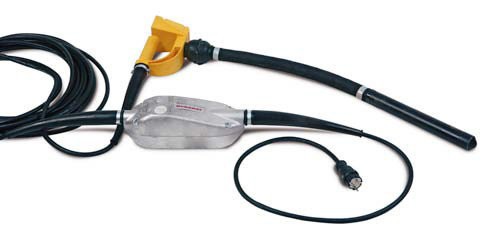Deep vibrators for concrete
A deep vibrator for concrete is a device for compacting a mixture inside formwork structures and other containers filled with concrete, for example, a foundation, a pool bowl, and so on.
The task of the deep vibrator is to compact the concrete, that is, to remove excess air and water particles from the space that was filled with concrete. Mechanical vibrations occur during operation vibrating head therefore, the concrete mixture will fill all corners of the formwork and acquire properties of greater adhesion.
The deep vibrator consists of:
- the tip or mace of a deep vibrator
- deep flexible shaft
- drive – motor
- voltage converter in the case of an electric drive
Maces There are eccentric and dome vibrators for deep vibrators.
Varieties and features of the use of deep vibrators
According to the type of engine, there are pneumatic, gasoline and electric deep vibrators.
Pneumatic ones cause vibrations vibrating head due to the flow of compressed air. They are well suited in industries with constant access to the network. Electric depth vibrators can be operated from a 220v network and are often used indoors or at an object where there is a limit on noise and emissions. Gasoline-powered vibrators are often used on large construction sites where there are no restrictions but a lot of power is needed.
Deep vibrators are divided into two groups:
1. Mechanical (pendulum) vibrators. The principle of operation of the devices is based on the vibration created by the impact of the pendulum on the mace with a frequency of 4-6 beats /rev. The shaft rotation speed is up to 3000 rpm. The equipment is suitable for small volumes of concrete work, as well as for facilities where there is no electricity.
Dignities:
- compact dimensions;
- simple prefabricated construction;
- maintainability;
- low cost;
- The oscillation frequency is up to 18 thousand/min.
The disadvantages of a mechanical deep vibrator for concrete include a limited shaft length (up to 9 m), the possibility of overheating of the drive. Vibration installation requires 2 operators.
2. High-frequency (pulse) deep vibrators. Devices equipped with an asynchronous motor, which is built into the vibrating head. When the engine is running, pulse oscillations with a frequency of 200 Hz are created. The speed of the vibration tool is 12000 vib./min. A deep vibrator for laying concrete is used for large volumes of monolithic work.
Dignities:
- flexible hose length up to 20 m;
- there is no risk of overheating of the drive;
- the presence of convenient handles - you need 1 operator to work;
- high power and performance;
- the ability to adjust the oscillation frequency.
The disadvantages of pulsed deep concrete vibrators include the need to connect to a power source, the complexity of repairs.
Using a deep vibrator to seal concrete:
- Always lower the vibrating tip vertically, having previously tested it on a container with a mixture.
- Always cover the area where you have already worked, so that there are no places where vibration is not transmitted to the mixture.
- Keep an eye on the duration and frequency of vibration inside the mixture, depending on its parameters.
- Do not touch the formwork walls with the mace.
- Do not turn on the deep vibrator outside of the mix.
- Always clean the equipment after work.
Characteristics of deep vibrators
Deep vibrators differ in size, power, type, number of vibration cycles, and availability of additional functions. The technical characteristics of deep vibrators must meet the requirements and the range of work carried out. The optimal number of vibration cycles is 5 thousand.
You can buy deep vibrators for concrete from well-known manufacturers:
- Dynapac (Sweden);
- Kem-P (Finland);
- OLI (Portugal);
- Vibromash (Russia);
- The Red Lighthouse (Russia).
The construction vibrators for concrete presented in the catalog are supplied with a set of accompanying documentation and a warranty.
The highest quality is a high-frequency deep vibrator, it is used in the construction of large monolithic structures. The device is easy to transport, has a small motor, and has a built-in converter. Most high-frequency vibrators have a vibration force control function.






























